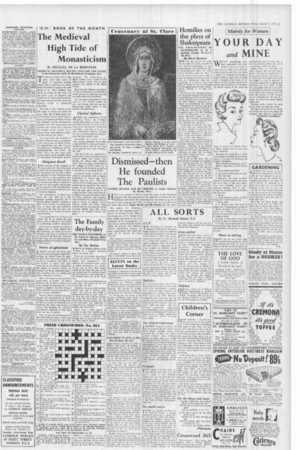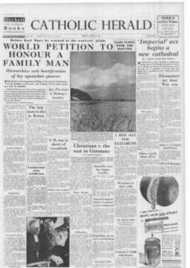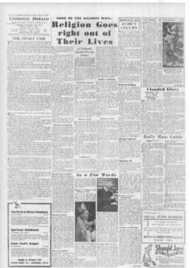Page 3, 7th August 1953
Page 3

Report an error
Noticed an error on this page?If you've noticed an error in this article please click here to report it.
Tags
Share
Related articles
A Study Of Monasteries Medieval Religious Houses In...
M Onasticism
History
Our Cathedral Heritage Our Christian Heritage By W....
Yes, The Church Is In Crisis
The Medieval High Tide of Monasticism
By MICHAEL DE LA BEDOYERE
MEDIEVAL RELIGIOUS HOUSES: ENGLAND AND WALES, by David Knowles and R. Neville Hadcock (Longmans, 42s.).
0 choose a book of this high
price, with only sonic 50
pages of narrative reading matter and no pictures, as a Book of the Month must seem a very odd thing to do. Yet I believe that many an owner of this work will get more years of pleasure and profit out of it than from hundreds of more normal choices from the flowing output of ephemeral literature.
The book in fact contains nearly 400 pages to which are added six maps. Over 300 of these pages contain tabulated lists of all the religious houses in England and Wales between the Conquest and the Reformation. together with brief descriptions and essential data about them. followed by statistics of the number of religious houses and religious at different dates during that period.
The maps show the locations of all these religious houses, according to their main groups. the Black Monks; the Augustinian% and other Canons; the Cistercians, Carthusians and Premonstratensians; the Friars; the Nuns; and a last one listing other groups which can be brought within the description of Religious Houses.
Eloquent detail
THE authority of the compilers is A a guarantee that this is the most accurate list and description at present obtainable, but for most readers the question of exact historical accuracy will be a very secondary consideration. What the book does in a way no narrative history could do is to give the most graphic and striking picture possible of the detailed Catholicity of this country during 400 years of Catholic England.
The accumulation of detail upon detail not only adds up to the greatest possible eloquence but it should enable Catholics, whether in their home districts or during holidays, to sense, feel and sometimes even touch the land that once was sanctified by these homes of prayer and dedication.
The majority have lost all traces, of course, but by no means all, and many a tour of discovery that would be a pilgrimage could be attempted.
This concrete evidence of Catholic religious life, so closely linked with the Continent, so varied in its expression, and often so emphatic in its service of the Holy Sec, makes it harder than ever to understand the Anglican thesis of Catholic continuity in this country.
Dawn of splendour
IHAVE said that this book only contains some 50 pages of narrative writing, yet without those 50 pages by Dom David Knowles, most of us would be completely lost. Here, in the briefest of spaces, that great authority on the subject summarises the phases of monastic history in England and Wales, admirably reducing a complex story to a simple and easily remembered pattern.
After a few pages on the pre-Conquest story, he begins: "In effect, however, the Norman Conquest not only marked the beginning of a new epoch in English monastic history, but served also to herald the dawn of a day of great splendour."
The first phase continued and augmented the establishment of Black Monks of St. Benedict, welding them in with the monks of Normandy, introducing the closer organisation of Cluny, and founding the cathedral monasteries. Nunneries at that time were very few in number.
Next, we have the development of the oldest kind of regular clerks, the Canons who followed the rule of Nt. Augustine. The Augustinians, or Black Canons, were a result of the Hildebrantine reform, but in most respects very similar to the Black Monks.
Then came the religious renaissance of Citeaux, Pir6montre and the Chartreuse. and we are told how, why and especially where they flourished.
An interesting development at this time was the "double" orders for men and women, with the one preReformation Order native to this country, the Gilbertines.
Clerical Fellows
A FTER some explanation of the ill. military Orders, the Templars and the Hospitallers, we have a brilliant r6sumd of the rise of the Friars, Franciscans. Dominicans, Austin and Carmelites. especially in terms of their intellectual influence through the towns, whereas previous monasticism had been mainly rural.
Meanwhile, the number of convents, though seemingly never large compared with the men, grew from a handful to about 150, of which the great majority were under Benedictine rule.
"The friars may be considered as the 19st great wave of the tide of monasticism which had flowed over Europe for almost nine hundred years." But more pages are devoted to the colleges of clerks living as a group and to the hospitals, as well as to the effects of the Black Death.
A pleasant touch is given by the writer in connection with collegiate foundations at Oxford and Cambridge when he says: "This subdivision of the college class, which in its turn may be regarded as the lowest species of the monastic genus. has been the only one to survive in its original habitat. Alone, and almost by accident, it escaped dissolution under the Tudor monarchs and remained, with its shadow of a common life and with its society of celibate clerical Fellows almost till within living memory the sole surviving relic of the monastic Middle Ages still recognised by the English Church and State."
blog comments powered by Disqus







